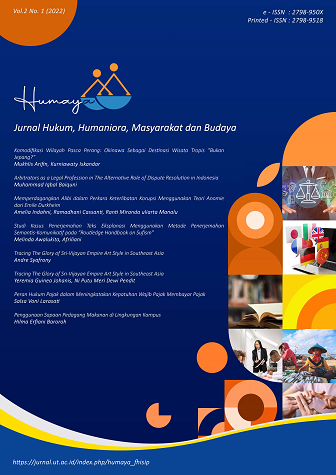Komodifikasi Wilayah Pasca Perang: Okinawa Sebagai Destinasi Wisata Tropis “Bukan Jepang?â€
DOI:
https://doi.org/10.33830/humaya_fhisip.v2i1.2361Keywords:
Dark tourism, Tourism, Commodification, OkinawaAbstract
This paper will review the commodification of tourism in Okinawa in the form of dark tourism and how the form of Japanese identity formation in Okinawa is basically "not Japanese." This research aims to understand how irony from tragedy becomes a commodity that can spur the economic pace of society. The concept of dark tourism and commodification will be the analysis knife in dissecting tourism activities in Okinawa. This paper uses literature study method; this paper will collect previous research and process it to understand how the commodification of tragedy can be of economic value. The study found that the tragedy can be valued as comodity by the tourist who looking for the past event as the comodity, but it will remain recorded in their collective memory as an unsolved problem in the affected community.
Tulisan ini mengulas tentang komodifikasi pariwisata di Okinawa dalam bentuk "Wisata Gelap" dan bagaimana bentuk pembentukan identitas Jepang di Okinawa pada dasarnya “bukan orang Jepangâ€. Penelitian ini bertujuan untuk memahami bagaimana ironi dari tragedi menjadi komoditas yang dapat memacu laju ekonomi masyarakat. Konsep dark tourism dan komodifikasi akan menjadi pisau analisis dalam membedah aktivitas pariwisata di Okinawa. Makalah ini menggunakan metode studi kepustakaan. Makalah ini mengumpulkan penelitian sebelumnya dan mengolahnya untuk memahami bagaimana komodifikasi tragedi dapat bernilai ekonomi. Studi ini menemukan bahwa tragedi dapat dinilai sebagai komoditas oleh para wisatawan yang melihat peristiwa masa lalu sebagai komoditas, tetapi akan tetap terekam dalam memori kolektif mereka sebagai masalah yang belum terpecahkan di masyarakat yang terkena dampak.
References
Bryman, A. (2012). Social Research Method (4th ed.). United Kingdom: Oxford University Press.
Cohen, E. (1972). Toward a Sociology of International Tourism. The Johns Hopkins University Press.
Cohen, E. (2011). Educational dark tourism at an in populo site: the holocaust museum in Jerusalem. Annals of Tourism Research.
Elliot, A., & Milne, D. (2019). War, Tourism, and Modern Japan. Japan Review 33(Special Issue), 3–28
Figal, G. (2008). Between War and Tropics: Heritage Tourism in Postwar Okinawa. University of California Press.
Hashimoto, A., & Telfer, D. J. (2019). Contested geopolitical messages for tourists at the Okinawa Peace Park and memorials. Japan Forum, 31:3, 378-407. doi:DOI: 10.1080/09555803.2018.1451354
Hones, G. (2000). Japan and tourism. Geographical Association.
Ide, A. (2012). Future Tourism in Hokkaido with a Comparison to Current Tourism in Okinawa. Evolutionary and Institutional Economics Review doi:doi.org/10.14441/eier.9.S101
Lisle, Richard J, Leyshon, Peter R, Lisle, Richard J., & Leyshon, Peter R. (2004). Stereographic projection techniques for geologists and civil engineers (2nd ed.). Cambridge University Press.
May, V. J. (1985). Changing patterns of tourism in Japan. Geographical Association Vol. 70, No. 3 250-251.
Murray, A. E. (2017). Footprints in Paradise: Ethnography of Ecotourism, Local Knowledge and Nature Therapies in Okinawa. Berghahn Books.
Nguyen, D. N. (2012). Tourism Development in Okinawa: Spatial and Temporal Patterns. University of Hawai’i
Nguyen, D. N. (2017). An archipelagic tourism development model: the case of Okinawa Prefecture. Asian Geographer, 34:1, 39-57. doi:DOI: 10.1080/10225706.2017.1323654
Ruoff, K. (2019). Wartime, War-Related, and National Heritage Tourism in Japan: Where Do We Go From Here? National Institute for the Humanities
Shimabuku, A. (2012). Transpacific Colonialism: An Intimate View of Transnational Activism in Okinawa. Michigan State University Press
Stone, P. (2006). A dark tourism spectrum: Towards a typology of death and macabre related tourist sites, attractions and exhibitions. Tourism: An Interdisciplinary Journal, 54 (2), 145–160
Tada, O. (2015). Constructing Okinawa as Japan’s Hawai`i: From Honeymoon Boom to Resort Paradise. Japanese Studies, 35:3, 287-302. doi:DOI: 10.1080/10371397.2015.1124745
Tanaka, Y., Bergstrom, J., & Shmyglo, O. (2003). The media representation of ‘Okinawa’ and US/Japan hegemony. Inter-Asia Cultural Studies, 4:3, 419-432.
Tarlow, P. E. (2005). Dark tourism: the appealing ‘dark’ side of tourism and more. Oxford: Elsevier, 47–57.
Watson, G. L., & Kopachevsk, J. P. (1994). Interpretation of Tourism as Commodity. Pergamon: USA.
Zabilka, G. (1959). Custom and Culture of Okinawa. Bridgeway Press.
Downloads
Published
How to Cite
Issue
Section
License
Copyright (c) 2022 Mukhlis Arifin

This work is licensed under a Creative Commons Attribution-NonCommercial-ShareAlike 4.0 International License.




